Adrian Collins's Blog, page 92
June 23, 2023
REVIEW: Immortal Longings by Chloe Gong
Chloe Gong rose to fame as the very young debut author of These Violent Delights, a retelling of Romeo and Juliet set in 1920s Shanghai. Clever and nuanced, she managed to weave themes of colonialism into her commercial YA novel. So when Immortal Longings, her adult debut loosely based on Shakespeare’s late tragedy Anthony and Cleopatra was announced, I was excited to see how her work would translate to a different audience. And while there is much to enjoy in Immortal Longings, the answer is unfortunately that it still feels very much like YA.
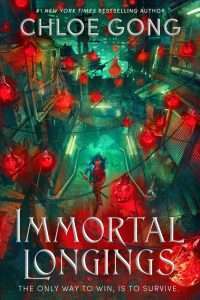 Set in San-Er, the capital twin cities of the kingdom of Talin, we encounter our main characters as participants at a rather brutal variation of the Roman panem et circensem – bread and games. Those in Talin confident in their ability to jump between bodies enter in fights to the death in order to win riches beyond compare – Calla, for a chance to murder her uncle, King Kasa, and finish her mission to rid the world of her tyrannical family having killed her parents years earlier, and Anton, to save his childhood love, who has lain in a coma for years. The two enter an unlikely alliance – one that can only end in devastation.
Set in San-Er, the capital twin cities of the kingdom of Talin, we encounter our main characters as participants at a rather brutal variation of the Roman panem et circensem – bread and games. Those in Talin confident in their ability to jump between bodies enter in fights to the death in order to win riches beyond compare – Calla, for a chance to murder her uncle, King Kasa, and finish her mission to rid the world of her tyrannical family having killed her parents years earlier, and Anton, to save his childhood love, who has lain in a coma for years. The two enter an unlikely alliance – one that can only end in devastation.
A lot of the approach to YA – even in scholarship – is “you know it when you see it”. This soft definition makes it difficult to have a clear distinction, especially in a crossover space. With Immortal Longings, the characters may be slightly older than usual, but their concerns and behaviour still feels like that of YA characters. If that is something you struggle with, this may not be the book for you – else, read on, because this is very much a book that will appeal to a Grimdark audience. When we meet Calla, she’s been on the run for years after killing her parents for the greater good. In D&D terminology – because that lets me talk about this without spoiling the story – Calla is lawful evil. She lives according to her own code of law and morality, but very clearly acts in ways seen as despicable from the outside. While she is trying to do what she considers to be the right things, she is clearly doing harm, and I found her a really interesting character to follow through a story. I hope that we see her mature a bit more, and see different sides to her in the next installment of the series.
Immortal Longings is full of betrayal, complex characters and dubious morality. I really appreciated the subtleness of Shakespeare’s Anthony and Cleopatra woven through. As the book is set in a futuristic secondary world, it took me quite a while to pick out the disparate elements and put them together into a narrative – which made Immortal Longings very fun to read. I did find that the pacing was a bit uneven, with the middle losing tension at times. The character arcs and the relationships between them felt a bit shallow, despite being set up with complex backstories that would have lent themselves to more depth. The story consistently confronted them with stakes higher than quite make sense given how they were portrayed. This – to me – added to the novel’s feeling like YA rather than adult, as it is a persistent trope of the category that the fate of the world is put on the shoulders of a handful of teenagers. While Immortal Longings didn’t read as discordant as many incumbents of the trope, it nevertheless drew on it – and drew on being part of this tradition.
So, while a very solid novel, Immortal Longings didn’t quite live up to the promise of ideas for me. It wasn’t quite mature enough to stand on its own feet, distinct from Chloe Gong’s YA work. I hope that the further books in the series will evolve and build on what did work well in Immortal Longings, and let her grow as a writer – because she has the right ideas and she can write. The ingredients are all there, it’s just not quite coming together yet. I’ll certainly be checking out the sequel to see how story and author have grown.
Read Immortal Longings by Chloe GongThe post REVIEW: Immortal Longings by Chloe Gong appeared first on Grimdark Magazine.
June 22, 2023
REVIEW: Night Angel Nemesis by Brent Weeks
Night Angel Nemesis is the latest novel from bestselling fantasy author Brent Weeks and marks a return to the world of his debut trilogy. The Night Angel Trilogy of The Way of Shadows, Shadow’s Edge, and Beyond the Shadows was released in 2008 by Orbit, before Grimdark Magazine was even a twinkle in the eye of the Internet. I cannot tell you how much I loved that original trilogy, but by now, my copies of the books are held together with sticky tape and good intentions. I was gleeful at returning to Week’s world with Night Angel Nemesis, the first of The Kylar Chronicles.
Sometimes,
reality can really disappoint with a new release you are most excited about. This was not the case here.
Even though Night Angel Nemesis is over eight hundred pages, almost every page holds readers’ attention. The fact that the stories set in Midcyru was billed as The Ka’Kari Codex fills me with the hope that this will become of the great vast series of the fantasy world. If I can have a whole shelf filled with novels from The Ka’Kari Codex, I will be delighted.
Night Angel Nemesis begins mere months after the final events of Beyond the Shadows. They are separate narratives, but many of the characters from the first trilogy are still key players in this novel. However, given that there is well over a decade between their publications, I think Night Angel Nemesis could only be enjoyed by having read (or carried out a recent reread) of the earlier novels. While not essential, it would vastly increase your understanding of the world and the characters. There are some characters in Night Angel Nemesis that only play a relatively small part in this novel but were much more critical in the original trilogy. In terms of the main characters, Kylar and Vi, what they went through before the events of Night Angel Nemesis is very relevant to why they are the way they are now. Weeks does summarise their histories very well as part of the narrative. Still, to get the complete picture, I think Night Angel Nemesis should be seen as a continuation of The Night Angel Trilogy rather than a completely independent novel.
In Night Angel Nemesis Kylar Stern is now a master assassin, rather than the street rat and apprentice wet boy we met before. Although we lose the repartee between Kylar and his former master, Durzo Blint, there is a similarly enjoyable back and-forth between Kylar and his Black Ka’kari, a magical artifact that enables Kylar to be the titular Night Angel – a supernatural assassin able to judge souls and dispatch those deserving of death. Kylar is also a broken man. He is alone – a widower mourning his wife and unborn child, and struggling to process events that saved thousands but cost him almost everyone he loves. The vast majority of Night Angel Nemesis is from Kylar’s perspective, so his grieving process and the growing ripples of a life of trauma play a significant role in the narrative. If Night Angel Nemesis is your starting point for this world, it is worth pointing out that, for all the dark humour in Weeks’ writing or Kylar’s jolly lack of social graces, this is a very bleak world. Happy endings do not last, and Kylar is no hero. He is not a soulless sociopath or a masked crusader and is wrecked by the choices forced upon him.
One of my favourite things about Night Angel Nemsis was the structure. It is an embedded narrative, and this “novel within a novel” is how the reader gets the perspective of Vi – aka Viridiana – who used to be an assassin to rival Kylar in skill but now serves as a sister in the magical order of The Chantry. As a reader, we see Vi as a character in the account Kylar has dictated and also get her perspective when she is “reading” the journal. This sounds quite like metafiction, and I accept that some readers may find it jarring or be frustrated by Weeks’ jumping in and out of the action or the breaking of the fourth wall (if it can be called that in a novel), but I found it to be very well executed and enjoyed it as a development of Weeks’ writing style for this world. It also served as a great tool to break away and deliberately gloss over things that may otherwise have felt gratuitous.
There were other departures from Weeks’ earlier style in Night Angel Nemesis which I liked. The female characters’ descriptions and roles feel like less of a sexy caricature. The fact that this novel’s key events are set around a heist rather than assassin training or war means fewer bloody outbursts. Weeks still does not shy away from the violence (indeed, if anyone remembers the moment from the first trilogy, which involves a barrel, olive oil, and a mole scenario, is utilised again in Night Angel Nemesis). Still, because it is not as common, it feels more effective.
Although this novel has its faults, I found them minor niggles in an otherwise great reading experience. I will be shoving Night Angel Nemesis into the palms of anyone who asks me for a dark and twisty recommendation. If any fans of grimdark are yet to discover this world, I thoroughly recommend it, and if, like me, you want to return to Midcyru I do not think you will be disappointed. It is one of my favourite reads of this year. Thank you so much to Brent Weeks and the team at Orbit for sending over a copy of Night Angel Nemesis for me to review.
5/5
PS I also purchased a beautiful special edition of Night Angel Nemesis from The Broken Binding. It is gorgeous, so if pretty books are your vice of choice, it might be worth seeing if they have any left in stock.
Read Night Angel Nemesis by Brent WeeksThe post REVIEW: Night Angel Nemesis by Brent Weeks appeared first on Grimdark Magazine.
June 21, 2023
REVIEW: Replika: Sky’s Mission by Hugo Bernard
Replika: Sky’s Mission by Hugo Bernard is about that popular science fiction topic of a simulated reality. We’re all familiar with The Matrix but it reminds me a lot more of The Thirteenth Floor, which is a less popular but more cerebral take on the subject. Replika addresses many of the issues of this and has a surprise twist at the end that I really should have seen coming.
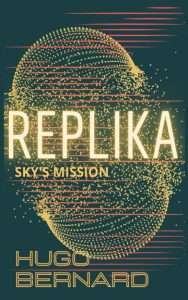 The premise is a woman named Vi is a genius scientist, who is being stalked by a mysterious figure named Hugo. Hugo has access to a seemingly unlimited number of resources but can’t get access to what he really wants: a boy named Henry. We then discover Henry has already gotten beyond Hugo’s grasp by entering Replika.
The premise is a woman named Vi is a genius scientist, who is being stalked by a mysterious figure named Hugo. Hugo has access to a seemingly unlimited number of resources but can’t get access to what he really wants: a boy named Henry. We then discover Henry has already gotten beyond Hugo’s grasp by entering Replika.
The in-universe Replika is a massive Matrix meets Second Life meets Metaverse sort of place that also functions like the Hotel California: You can check out any time you like but you can never leave. As a means of preserving resources, humanity has stuck a huge chunk of their population in a perpetual virtual reality where the rest of mankind struggles to repair the environmentally damaged world. Whether it’s a brain upload or your body is stuck in a tube somewhere is unclear, but it is a permanent sign-up as your memory is erased of your previous life when you enter this digital afterlife.
Back in the “real” world, though, Sky is a young woman who has devoted herself to trying to heal the environmentally damaged world she lives in. The people who choose not to go into Replika are fanatics, of a sort, who disdain anything associated with the digital world even if it could be used to help them repair the planet. As Vi’s daughter, she has her own complicated feelings regarding Replika and misses her missing brother. A bad breakup brought about by smugglers convinces her that she should try to find her brother in Replika–but is it possible?
There’s a lot of twists and turns in this novel as we deal with questions of reality, recursive reality, and the purpose of life in general. Much is made of what they could have changed for society in the simulated universe and why the creators’ lacked imagination. Why not give people wings, make them immortal, or make a paradise for them to live in? Is not the struggle for things part of what motivates us to do anything, though?
I think this is a very solid dystopian science fiction novel with a lot of high concepts but not so much that it’s incomprehensible to readers just looking for a good time. I think it’s a very enjoyable book and people looking for something that taps into the concepts of our shared experience as human beings will enjoy it. How important is our life that we experience through fiction? Is the fact it’s fake something that renders it unimportant or is the meaning we take from it equally important? I look forward to reading more into it in the sequels as this was written as a trilogy. It’s also thankfully done so you can just pick up all three.
Read Replika: Sky’s Mission by Hugo Bernard
The post REVIEW: Replika: Sky’s Mission by Hugo Bernard appeared first on Grimdark Magazine.
June 20, 2023
REVIEW: The Vessel by Adam Nevill
The Vessel opens with protagonist Jess McMachen in a desperate situation. Having separated from her violent husband, she supports herself on meager wages earned weekly as a caregiver for the elderly. Her primary school-aged daughter Izzy is mercilessly bullied by her classmates, but Jess’ irregular work schedule prevents her from being as available for her daughter as she would like. Her ex-husband is also constantly lurking around the periphery, paying surprise visits to their daughter that violate the terms of their divorce agreement. A new job opportunity offers a chance to escape this tenuous situation, however. If Jess can stick with it, avoiding a repeat of the vaguely hinted-at disaster that spoiled her previous posting, she could earn enough to move into a new house in the countryside, far from her ex-husband, where her daughter can play outside and get a fresh start at a new school.
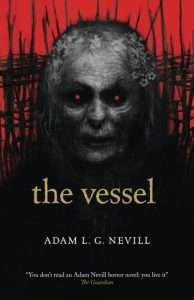 Upon accepting the new job, however, the situation quickly goes from bad to worse. Her client, Flo Gardner, is in the late stages of dementia. She lives in Nerthus House, a once beautiful mansion that (mirroring its owner) has deteriorated over the decades, dimmed by unreplaced burnt-out light bulbs and crammed with a lifetime of clutter. Jess soon discovers that—during those fleeting moments when Flo isn’t completely catatonic—she’s verbally abusive without provocation and unpredictably violent. Flo also proves surprisingly mobile for a supposedly frail wheelchair user, appearing in unexpected places in the dead of night. Jess keeps discovering strange shrines in neglected corners of the house. Birds act strangely in the surrounding woods, and ominous shapes move in the overgrown garden at night. There is a sense that both Nerthus House and its resident are awaiting something. The eerie events Jess experiences escalate even further when, after her babysitting arrangements fall through, she finds herself with no choice but to bring her daughter into Nerthus House and into contact with Flo.
Upon accepting the new job, however, the situation quickly goes from bad to worse. Her client, Flo Gardner, is in the late stages of dementia. She lives in Nerthus House, a once beautiful mansion that (mirroring its owner) has deteriorated over the decades, dimmed by unreplaced burnt-out light bulbs and crammed with a lifetime of clutter. Jess soon discovers that—during those fleeting moments when Flo isn’t completely catatonic—she’s verbally abusive without provocation and unpredictably violent. Flo also proves surprisingly mobile for a supposedly frail wheelchair user, appearing in unexpected places in the dead of night. Jess keeps discovering strange shrines in neglected corners of the house. Birds act strangely in the surrounding woods, and ominous shapes move in the overgrown garden at night. There is a sense that both Nerthus House and its resident are awaiting something. The eerie events Jess experiences escalate even further when, after her babysitting arrangements fall through, she finds herself with no choice but to bring her daughter into Nerthus House and into contact with Flo.
Much like Nevill’s The Ritual and No One Gets Out Alive, The Vessel deals with an isolated protagonist trapped in a simultaneously miserable and threatening predicament. “Why don’t they just leave?” is a question that horror writers and filmmakers frequently have to grapple with, and Nevill always has a ready and convincing response. He combines empathetic character portrayals with a singularly claustrophobic atmosphere, effectively immersing the reader in his beleaguered protagonists’ shoes.
Apart from its sudden and intense finale, The Vessel is more about inevitability than surprises. Rather than blindside the reader with twists and unexpected reveals, the events of the story seem to follow an inexorable, perhaps even preordained sequence. The reader is kept one step ahead of Jess throughout the story, enhancing the feel of dread.
Only slightly longer than a novella, The Vessel is a short novel intended by the author to be read in one or two sittings. While I appreciated that it wasted no time getting to the exciting supernatural bits, it also felt like the novel would have been perhaps even more effective with some more meat on its bones, so to speak. In the book’s enlightening back matter, Nevill reveals that the narrative’s leanness and almost stage-like presentation were an intentional experiment on his part. Ultimately, whether that experiment was successful will depend on the perspective of each individual reader, and I will refrain from spoiling Nevill’s stated goal for the book.
The Vessel is a taut little exercise in folk horror. Reader’s familiar with Nevill’s other work will find his strengths on display, and newcomers with a taste for folk horror in the tradition of Arthur Machen (slyly referenced in Nevill’s heroine’s surname: McMachen) and The Wicker Man are sure to enjoy this tale. The old gods of Britain may have faded from sight, but that doesn’t mean they have disappeared.
Read The Vessel by Adam NevillThe post REVIEW: The Vessel by Adam Nevill appeared first on Grimdark Magazine.
June 19, 2023
REVIEW: Mothtown by Caroline Hardaker
Caroline Hardaker’s Mothtown is haunting, atmospheric and wonderfully uncanny. It is a novel unlike any other, tiptoeing that fine line between obsession and the supernatural with great skill, leaving the reader feeling uneasy until the very end. This is her second literary horror novel with Angry Robot after 2021’s Composite Creatures, and Mothtown builds and grows on the strengths of her debut.
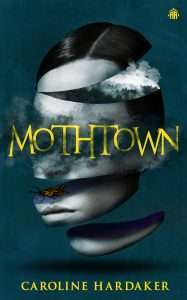 Mothtown is a horror novel, but not one as you might imagine hearing the term. There is no blood or gore, there are no ghosts in the traditional sense. The story revolves around David, ten years old when his grandfather passes away. Despite his young age, he quickly realises that something didn’t quite add up and becomes consumed by figuring out what happened to his beloved grandfather. And he soon finds out that in this world, people go missing far more often than you’d think. As he grows up, he gets drawn deeper and deeper into his obsession – convinced his grandfather is still alive somewhere in a different world.
Mothtown is a horror novel, but not one as you might imagine hearing the term. There is no blood or gore, there are no ghosts in the traditional sense. The story revolves around David, ten years old when his grandfather passes away. Despite his young age, he quickly realises that something didn’t quite add up and becomes consumed by figuring out what happened to his beloved grandfather. And he soon finds out that in this world, people go missing far more often than you’d think. As he grows up, he gets drawn deeper and deeper into his obsession – convinced his grandfather is still alive somewhere in a different world.
The story’s biggest strength is its writing. Outside of writing fiction, Hardaker is also a poet, and that shows in how she uses words. While the plot itself is relatively straightforward, Hardaker’s telling of it makes it exciting and evocative. Much of what makes the uncanny horror aspects work as well as it does is down to how it is written, using words to really effectively create an atmosphere and bring these characters to life. The story is illustrated by Chris Riddell, marking key moments with his unique pencil drawings. I will always fall for adult books with interior illustrations (such as Spear), and with Mothtown too, Chris Riddell’s style and choice of illustrations manage to complement and enhance the story in just the right way to add another dimension.
I am sure that Mothtown is a story that will stick with me for a long time to come and personally, I am looking forward to reading more Caroline Hardaker. There is much to enjoy for the Grimdark reader too, with complex characters driven by selfish motives – emotional hurt is just as (grim)dark as physical hurt, after all. Highly recommended.
Read Mothtown by Caroline HardakerThe post REVIEW: Mothtown by Caroline Hardaker appeared first on Grimdark Magazine.
June 18, 2023
REVIEW: Diablo 4 full release
In Diablo 4, the latest major release from Blizzard, a band of adventurers break into an ancient tomb, and their quest for gold accidentally unleashes Lilith, The Daughter of Hatred, The Mother of Sanctuary. And so begins another demon slaying gorefest in the gaming colossus that is the Diablo universe.
Having already reviewed the Beta release in May and been wildly impressed, I had a list of things I was hoping to see and not see from Blizzard. I wanted to explore more, I wanted to see what there was to see. I wanted to complete more acts, get that darned horse to ride around on, find more magic levels and more epic items, and see some levelling out of character powers (eg. the wildly overpowered necromancer needed a chill pill). For the most part, Blizzard have delivered in spades. Diablo 4 is a brilliant, fun, beautiful, dark, and wildly addictive gaming experience, and has healed the wounds left over from Diablo 3.
In Diablo 4, once you have discovered Lilith is on the loose, you run through a series of Acts slaying millions of beasties, and interact with a small cast of key characters. Lorath is your mandated Horadrim buddy who starts out as a grand dad-style mentor, and slowly becomes more world weary every act. Donan is a hero from yesteryear who once imprisoned a Prime Evil. He’s seen better days, however, and one decision regarding the son he dotes upon and fiercely protects throws him into the emotional meatgrinder. Finally we have Nyrelle, who you are told early on is far more important than Lorath or Donan. She starts as a somewhat annoying child making annoying child decisions to drive plot, and becomes pretty badarse along the way. The interplay between the Evils is also pretty cool–it’s the first real deep-dive into their own politics that I really remember. The ending is also deliciously open-ended, leaving plenty of opportunity for expansions. Overarchingly the story is pretty good, but if you love going off dungeon hunting and clearing out entire regions of the foe and you’re not laser focussed on completing just the steps in the story (or have an eidetic memory), it can get a bit hard to follow at times (which can be seen as a good there because there is so much to do!). But, if we’re being honest, most of us are here for the action-stacked gorefest, and not to watch a movie plot (though, in fairness to Blizzard’s story team, I certainly sit in the latter camp and have enjoyed it so far).
There are five characters available for you to play. The necromancer I mentioned earlier–who after Sally in our original beta release review was able to wander off with her partner for dinner and leave the necromancer army just sitter there gaining experience near a spawn point, was safe to say was overpowered–has now been nerfed down to a much more enjoyable and competitive level. I played as the barbarian, and while some of the lower level sword swishing was a little weaker than the last time I played one in Diablo 2, it was an incredibly fun experience, especially when my wife played the necromancer and I was able to power up her skeletons and golem with war shouts. The rogue and sorcerer (two characters whose styles I’m relatively sure I won’t have to explain to you) I have not played and cannot vouch for, and the druid (lycanthropy being it’s coolest trait, in my opinion) I hope remained relatively level to the beta version, which I previously reviewed and enjoyed getting to level 20. All in all, Diablo 4 has an excellent cast of characters to play through as, though I will admit to missing the paladin and their massive shield bashes from previous games.
The terrain and setups for Diablo 4 are just … chef’s kiss. The scenery is absolutely fucking gorgeous, and the way the world and map is built where it’s treated more like a genuine open world map, versus a linear series of closed-in playpens is a HUGE selling point of this game. It’s a major upgrade versus previous Diablo games, and it really creates a new and brilliant world travelling feel, with waypoints allowing you to teleport between the many, many towns and cities—each which feels unique and changes depending on the closer you are to the continent’s interior, mountains, or beaches. The level of detail in this map is utterly astonishing, and the Blizzard art and design team need a round of very crisp high fives for the love and passion they put into this map (not to mention Hell, which is phenomenal). If I’m going to pick nits, I do still wish Blizzard would return to the days of limiting town portals to add to the danger of leaving the safety of a town, though.
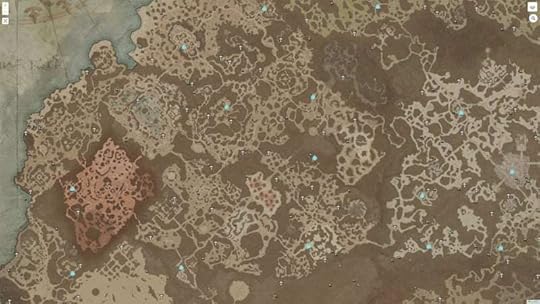
A small part of the Diablo 4 map, showcasing regions, towns, waypoints, and the coastline.
It also wouldn’t be Diablo without all the stuff you find, and break down, and sell, and create. The systems in Diablo 4 remain relatively familiar to long term fans of the Diablo franchise. You can find cool pieces of weapons and armour, they generally improve your stats in one way or another, and you swap them out from standard, to magical, rare, and legendary as you progress. I’ll admit to this being one of my less favourite aspects of Diablo 4, and this may be perhaps to me viewing the halcyon days of Diablo 1 and 2 through something like 20+ year old rose-cloured glasses, but I liked it when the awesome items were few and far between, you held on to your kit for longer, and you could build suits of matching legendary or unique items that further levelled up your stats. It felt like you had to earn and chase your kit, versus it just falling out of frog’s arse when it hopped conveniently by. Diablo 3 was way over the top, where it felt like it was just raining gold and magical items, and Diablo 4 admittedly has dialled it back a bit, which is nice, but I don’t think they’ve gone far enough. In addition, the way that magical items that drop on the floor are auto-allocated to a player isn’t something I’m the biggest fan of–it in no way supports my muscle reflex of desperately clicking on everything that falls on the ground before anyone else can so I can then see what I have to trade and barter with other players.
In addition to the stuff you can find and buy with gold at the armourers, jewellers, blacksmith’s, etc, Diablo 4 gives you the ability to change the way your character looks (eg. despite finding a squiggly sword, you might have a skin where you can stick with a straight-edged broadsword). You get some levels for free, but as seems to be the standard with modern gaming, an in-game micro-transaction shop for armour cosmetics has appeared for the first time in Diablo. I’m personally a bit disappointed to see it there, however, I’m an adult and I can choose not to spend my money on something like that. The eternal argument between gamers and developers on this topic can keep on raging, but the only warning I can give is that if you’re a parent and your sprout is playing this, just make sure you watch out for this (because the coolest looking skins are of course for purchase only).
Finally, the cinematics are just utterly fucking gorgeous, from the action to the the membranous blood petals and the birth of Lilith into the world of Sanctuary. Just bloody stunning. And the way they set up the story and shift you from act to act is so good. I’ve always loved the cinematics in Diablo, and I think the team at Blizzard has once again one-upped themselves to provide story support through highly detailed and action-packed animation. The scene where you make it a little of the way into Hell (those of you who have been in there will know of which I speak) is going to go down as one of my all time favourite animations (right next to The Battle on the Amerigo from Starcraft 1).
One major complaint Sally and I both had is the amount of times we got kicked off the server, right in line with when the wave of traffic that is the US market behemoth waking up hits. Almost without fail, my wife and I got punted in our late evening (in Australia) and Sally and her partner had the similar experience playing from the UK around midday their time. While the benefits are clearly getting to run around with other players the world around (and let’s be honest, I’m buggered if I know how you’d defeat some of the bosses without a little help) the battle.net platform can be a huge pain when you’re not in the US. I also wouldn’t have minded finding the horse earlier to make swishing through certain stages a bit easier, but that’s not the end of the world.
Overall, Diablo 4 is going to be an instant classic with fans new and old of this franchise. There is absolutely no question in my mind. It’s beautiful, innovative, and wildly addictive fun. There is also so much possible over the coming years. Potentially hopping on a boat and sailing to another continent while battling sea monsters, or crossing the mountains up north, maybe they could bring back mercenaries (I was so upset they weren’t in this; I was very attached to my one in Diablo 2) and runes and legendary item sets and … and … and … I think, when you look at the things I’m lamenting not being foundational games mechanics or people being able to buy epic actual weapons and armour to cash their way forward, you’ll know for sure that this is a game you want. just be ready to reach the end of 2023 and wonder just where the hell all your free time went as Lilith laughs at you from the front cover.
5/5
A big thank you to Sally Berrow for reviewing this with me, and to Blizzard for the review code.
Play Diablo 4The post REVIEW: Diablo 4 full release appeared first on Grimdark Magazine.
8 new and upcoming SFF and horror releases for grimdark fans to celebrate Pride Month 2023
In June, we celebrate and commemorate the Pride movement – recognising the LGBTQ+ movement and celebrating its culture. Throughout this month, we have been sharing some of our favourite queer reads on the GdM social media, but here are our chosen 2023 new and upcoming releases. Not only do these novels all offer the fantasy escapism we all like, but they also have great representations of queer characters and are all written by authors who are part of the LGBTQ+ community.
Camp Damascus by Chuck Tingle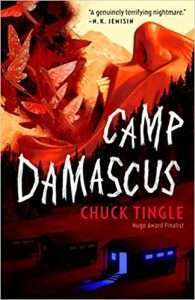 Camp Damascus is a truly terrifying supernatural horror novel set at the ‘most effective’ gay conversion camp in the country. Tingle’s horror debut has been described as ‘searing and earnest’ about the demons faced by the queer community. Though there are also real demons in Camp Damascus, and they need to be killed. Camp Damascus is out in July.
Camp Damascus is a truly terrifying supernatural horror novel set at the ‘most effective’ gay conversion camp in the country. Tingle’s horror debut has been described as ‘searing and earnest’ about the demons faced by the queer community. Though there are also real demons in Camp Damascus, and they need to be killed. Camp Damascus is out in July.
Read our review here.
About the bookWelcome to Neverton, Montana: home to a God-fearing community with a heart of gold.
Nestled high up in the mountains is Camp Damascus, the self-proclaimed “most effective” gay conversion camp in the country. Here, a life free from sin awaits. But the secret behind that success is anything but holy.
And they’ll scare you straight to hell.
Read the bookFeed Them Silence by Lee Mandelo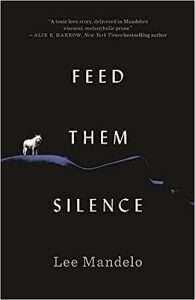 A science fiction novella set in the near future, Lee Mandelo’s Feed Them Silence focuses on what it means to ‘be in kind’ with a non-human animal. It shows us Dr. Sean Kell-Luddon’s obsession with her research, how this dream impacts the relationship with her wife, and the terrible cost it wreaks on both Sean’s body and brain and the wolf she is tampering with. Feed Them Silence is out now.
A science fiction novella set in the near future, Lee Mandelo’s Feed Them Silence focuses on what it means to ‘be in kind’ with a non-human animal. It shows us Dr. Sean Kell-Luddon’s obsession with her research, how this dream impacts the relationship with her wife, and the terrible cost it wreaks on both Sean’s body and brain and the wolf she is tampering with. Feed Them Silence is out now.
Read our review here.
About the bookWhat does it mean to “be-in-kind” with a nonhuman animal? Or in Dr. Sean Kell-Luddon’s case, to be in-kind with one of the last remaining wild wolves? Using a neurological interface to translate her animal subject’s perception through her own mind, Sean intends to chase both her scientific curiosity and her secret, lifelong desire to experience the intimacy and freedom of wolfishness. To see the world through animal eyes; smell the forest, thick with olfactory messages; even taste the blood and viscera of a fresh kill. And, above all, to feel the belonging of the pack.
Sean’s tireless research gives her a chance to fulfill that dream, but pursuing it has a terrible cost. Her obsession with work endangers her fraying relationship with her wife. Her research methods threaten her mind and body. And the attention of her VC funders could destroy her subject, the beautiful wild wolf whose mental world she’s invading.
Read the bookHe Who Drowned the World by Shelley Parker-Chan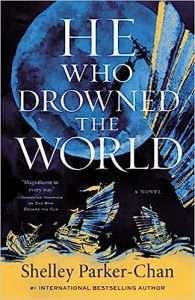 The second book in The Radiant Empire series He Who Drowned the World is a Chinese-inspired military fantasy. It follows Zhu Yuanzhang, the Radiant King, after her victory over the Mongols and her mission to seize the throne and crown herself emperor against any and all contenders. He Who Drowned the World is due out in August. You can read our She Who Became the Sun review on the site and find Shelley Parker- Chan on our list of ‘Rising Stars of Grimdark’ list.
The second book in The Radiant Empire series He Who Drowned the World is a Chinese-inspired military fantasy. It follows Zhu Yuanzhang, the Radiant King, after her victory over the Mongols and her mission to seize the throne and crown herself emperor against any and all contenders. He Who Drowned the World is due out in August. You can read our She Who Became the Sun review on the site and find Shelley Parker- Chan on our list of ‘Rising Stars of Grimdark’ list.
How much would you give to win the world?
Zhu Yuanzhang, the Radiant King, is riding high after her victory that tore southern China from its Mongol masters. Now she burns with a new desire: to seize the throne and crown herself emperor.
But Zhu isn’t the only one with imperial ambitions. Her neighbor in the south, the courtesan Madam Zhang, wants the throne for her husband―and she’s strong enough to wipe Zhu off the map. To stay in the game, Zhu will have to gamble everything on a risky alliance with an old enemy: the talented but unstable eunuch general Ouyang, who has already sacrificed everything for a chance at revenge on his father’s killer, the Great Khan.
Unbeknownst to the southerners, a new contender is even closer to the throne. The scorned scholar Wang Baoxiang has maneuvered his way into the capital, and his lethal court games threaten to bring the empire to its knees. For Baoxiang also desires revenge: to become the most degenerate Great Khan in history―and in so doing, make a mockery of every value his Mongol warrior family loved more than him.
All the contenders are determined to do whatever it takes to win. But when desire is the size of the world, the price could be too much for even the most ruthless heart to bear…
Read the bookAlecto the Ninth by Tamsyn Muir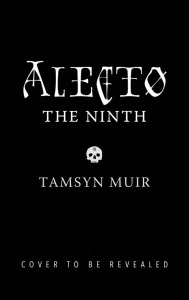 We love Tamsyn Muir at Team GdM, all the novels in The Locked Tomb series (Gideon the Ninth, Harrow the Ninth, and Nona the Ninth) were well received by our crew, and this fourth and final installment of Alecto the Ninth landed a spot on our SFF books we can’t wait to read in 2023. It feels like the rest of the series has been building to an epic finale in Alecto the Ninth, and it’s so exciting to read the conclusion of this wondrous lesbian necromancer space opera. Alecto the Ninth is due out in October.
We love Tamsyn Muir at Team GdM, all the novels in The Locked Tomb series (Gideon the Ninth, Harrow the Ninth, and Nona the Ninth) were well received by our crew, and this fourth and final installment of Alecto the Ninth landed a spot on our SFF books we can’t wait to read in 2023. It feels like the rest of the series has been building to an epic finale in Alecto the Ninth, and it’s so exciting to read the conclusion of this wondrous lesbian necromancer space opera. Alecto the Ninth is due out in October.
The fourth installment in The Locked Tomb series—Gideon the Ninth, Harrow the Ninth, Nona the Ninth, and Alecto the Ninth—is an epic science fantasy that blends necromantic theory and thrilling swordplay with a wicked, sacrilegious sense of humor; a modern mix of Dune, Riddick, and Gormenghast.
Read the bookPre-order to come from Tordot com.
To Shape a Dragon’s Breath by Moniquill Blackgoose
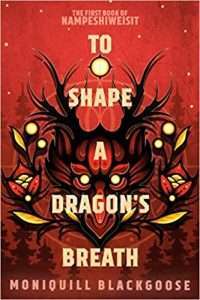 The Grimdark Magazine review for To Shape a Dragon’s Breath called it ‘one blazing epic gulp of a fantastic tale’ and if that doesn’t make you want to read it I don’t know what will. Blackgoose has some wonderful characters in her novel and she manages to create a good dark fantasy world which is queer, anti-colonialist, and chock full of dragons. It is the first in a series and To Shape a Dragon’s Breath is out now and you can read our full review on the Grimdark Magazine site.
The Grimdark Magazine review for To Shape a Dragon’s Breath called it ‘one blazing epic gulp of a fantastic tale’ and if that doesn’t make you want to read it I don’t know what will. Blackgoose has some wonderful characters in her novel and she manages to create a good dark fantasy world which is queer, anti-colonialist, and chock full of dragons. It is the first in a series and To Shape a Dragon’s Breath is out now and you can read our full review on the Grimdark Magazine site.
Read our review here.
About the bookThe remote island of Masquapaug has not seen a dragon in many generations—until fifteen-year-old Anequs finds a dragon’s egg and bonds with its hatchling. Her people are delighted, for all remember the tales of the days when dragons lived among them and danced away the storms of autumn, enabling the people to thrive. To them, Anequs is revered as Nampeshiweisit—a person in a unique relationship with a dragon.
Unfortunately for Anequs, the Anglish conquerors of her land have different opinions. They have a very specific idea of how a dragon should be raised, and who should be doing the raising—and Anequs does not meet any of their requirements. Only with great reluctance do they allow Anequs to enroll in a proper Anglish dragon school on the mainland. If she cannot succeed there, her dragon will be killed.
For a girl with no formal schooling, a non-Anglish upbringing, and a very different understanding of the history of her land, challenges abound—both socially and academically. But Anequs is smart, determined, and resolved to learn what she needs to help her dragon, even if it means teaching herself. The one thing she refuses to do, however, is become the meek Anglish miss that everyone expects.
Anequs and her dragon may be coming of age, but they’re also coming to power, and that brings an important realization: the world needs changing—and they might just be the ones to do it.
Read the bookGodkiller by Hannah Kaner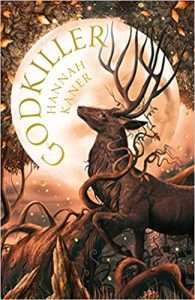 Hannah Kaner’s debut fantasy novel not only featured on the lauded Sunday Times bestseller list, but Kaner landed a spot on both our SFF books we can’t wait to read in 2023 and our Rising Stars of Grimdark lists. Godkiller follows Kissen, a godkiller who finds herself in trouble when she meets a god she cannot kill – Skedi, the god of white lies because killing him will cause the death of the human girl he is linked to. You can read our full review of Godkiller here, and it is out now.
Hannah Kaner’s debut fantasy novel not only featured on the lauded Sunday Times bestseller list, but Kaner landed a spot on both our SFF books we can’t wait to read in 2023 and our Rising Stars of Grimdark lists. Godkiller follows Kissen, a godkiller who finds herself in trouble when she meets a god she cannot kill – Skedi, the god of white lies because killing him will cause the death of the human girl he is linked to. You can read our full review of Godkiller here, and it is out now.
Read our review here.
About the bookYou are not welcome here, godkiller.
Kissen’s family were killed by zealots of a fire god. Now, she makes a living killing gods, and enjoys it. That is until she finds a god she cannot kill: Skedi, a god of white lies, has somehow bound himself to a young noble, and they are both on the run from unknown assassins.
Joined by a disillusioned knight on a secret quest, they must travel to the ruined city of Blenraden, where the last of the wild gods reside, to each beg a favour.
Pursued by demons, and in the midst of burgeoning civil war, they will all face a reckoning – something is rotting at the heart of their world, and only they can be the ones to stop it.
Read the bookDragonfall by L R Lam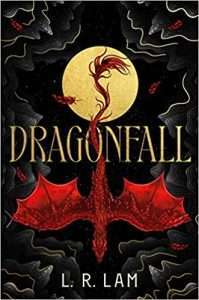 In Dragonfall non binary author L R Lam has created not only a queernorm world, in terms of sexuality and gender. It is part of the social structure to introduce yourself with your preferred pronouns – one of the lead characters Arcady is non binary and doesn’t mind which you use. The other, Everen, is a smidgen confused by the whole thing, but as a shapeshifted dragon with minimal worldly experience, we can forgive him. Dragonfall is a great new world, the first in a trilogy, which you can read more about in our review of the novel here. It is out now.
In Dragonfall non binary author L R Lam has created not only a queernorm world, in terms of sexuality and gender. It is part of the social structure to introduce yourself with your preferred pronouns – one of the lead characters Arcady is non binary and doesn’t mind which you use. The other, Everen, is a smidgen confused by the whole thing, but as a shapeshifted dragon with minimal worldly experience, we can forgive him. Dragonfall is a great new world, the first in a trilogy, which you can read more about in our review of the novel here. It is out now.
Read our review here.
About the bookLong-banished dragons, revered as gods, return to the mortal realm in the first in this magical new epic fantasy trilogy from a bestselling author
Long ago, humans betrayed dragons, stealing their magic and banishing them to a dying world. Centuries later, their descendants worship dragons as gods. But the “gods” remember, and they do not forgive.
Thief Arcady scrapes a living on the streets of Vatra. Desperate, Arcady steals a powerful artifact from the bones of the Plaguebringer, the most hated person in Lumet history. Only Arcady knows the artifact’s magic holds the key to a new life among the nobles at court and a chance for revenge.
The spell connects to Everen, the last male dragon foretold to save his kind, dragging him through the Veil. Disguised as a human, Everen soon learns that to regain his true power and form and fulfil his destiny, he only needs to convince one little thief to trust him enough to bond completely–body, mind, and soul—and then kill them.
Yet the closer the two become, the greater the risk both their worlds will shatter.
Read the bookA Day of Fallen Night by Samantha Shannon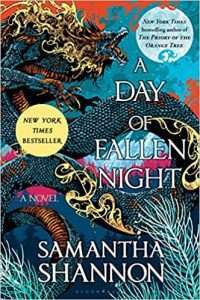 Samantha Shannon is an exquisite writer, and her sensational The Priory of the Orange Tree is a key part of feminist fantasy reading. In A Day of Fallen Night Shannon returns to the same world with a cast of new characters in a standalone novel set half a millennia earlier. Our reviewer described it as ‘a beautifully written epic fantasy’, and A Day of Fallen Night offers a significant amount of entertainment at nearly nine hundred pages long. A Day of Fallen Night is out now.
Samantha Shannon is an exquisite writer, and her sensational The Priory of the Orange Tree is a key part of feminist fantasy reading. In A Day of Fallen Night Shannon returns to the same world with a cast of new characters in a standalone novel set half a millennia earlier. Our reviewer described it as ‘a beautifully written epic fantasy’, and A Day of Fallen Night offers a significant amount of entertainment at nearly nine hundred pages long. A Day of Fallen Night is out now.
Read out review here.
About the bookIn A Day of Fallen Night, Samantha Shannon sweeps readers back to the universe of Priory of the Orange Tree and into the lives of four women, showing us a course of events that shaped their world for generations to come.
Tunuva Melim is a sister of the Priory. For fifty years, she has trained to slay wyrms – but none have appeared since the Nameless One, and the younger generation is starting to question the Priory’s purpose.
To the north, in the Queendom of Inys, Sabran the Ambitious has married the new King of Hróth, narrowly saving both realms from ruin. Their daughter, Glorian, trails in their shadow – exactly where she wants to be.
The dragons of the East have slept for centuries. Dumai has spent her life in a Seiikinese mountain temple, trying to wake the gods from their long slumber. Now someone from her mother’s past is coming to upend her fate.
When the Dreadmount erupts, bringing with it an age of terror and violence, these women must find the strength to protect humankind from a devastating threat.
Read the book
The post 8 new and upcoming SFF and horror releases for grimdark fans to celebrate Pride Month 2023 appeared first on Grimdark Magazine.
REVIEW: Camp Damascus by Chuck Tingle
Camp Damascus did not begin where I expected it to. The title and blurb suggest it might be set in a conversion camp that is hiding even more than the usual. On the contrary, very little of the active storyline actually happens in Camp Damascus. We join the first-person POV main character of Rose as she approaches her high school graduation, trying to enjoy a normal summer in the town of Neverton, where she has been raised in the faith of evangelical, strict, and staunchly patriarchal sect Kingdom of the Pine.
 Before we continue, I will give you some content warnings for both the book content and, by dint of reviewing said book, this review. This book features themes on the persecution of LGBTQIA+ people, I mention the real-world parallels here, there’s religious cults, mentions of and implications of the torture of LGBT youth (including children) and extreme conversion therapy with a supernatural twist. If you’re not feeling up to it right now, keep yourself safe; there’s no obligation to read on.
Before we continue, I will give you some content warnings for both the book content and, by dint of reviewing said book, this review. This book features themes on the persecution of LGBTQIA+ people, I mention the real-world parallels here, there’s religious cults, mentions of and implications of the torture of LGBT youth (including children) and extreme conversion therapy with a supernatural twist. If you’re not feeling up to it right now, keep yourself safe; there’s no obligation to read on.
Rose enjoys spending time with her friend Martina and finds her company electrifying but she’s not gay. Absolutely not. No way. Rose’s parents are trying to set her up with friend Isaiah (a fellow Kingdom kid), who she has no interest in that way. Chuck Tingle’s method of queer-coding Rose as a young, in-denial lesbian is both clever and powerful. As readers, we can see what’s going on but Rose herself is – as yet – none the wiser. She also feels neurodiverse in how Tingle has written her, and other neurodiverse folk will be able to home in on this.
Frightening, odd things start to happen when she thinks of Martina; a dishevelled, hunched woman with elongated fingers starts to appear. She’s wearing a red uniform. While daydreaming after seeing a Camp Damascus commercial on the television, the dishevelled woman appears in Rose’s home, charging at her, before hiding in a closet. Awoken by Rose’s screams, her parents exchange worried-yet-knowing glances as they open the closet to reveal it empty.
Something feels very wrong, as if the whole wide world is in on some joke that I’m completely oblivious to.
Not long after this encounter, Rose’s close friend Martina meets a grizzly fate at the hands of the madwoman stalking Rose. In her deepest grief, she believes this woman to be a demon – attached to her for reasons she doesn’t understand. On a late night drive, Rose encounters another demon, this time a man with the same haggard appearance and red uniform. Attempting to run him down with her car causes a severe crash. While she escapes the demon, Rose ends up hospitalised on a hefty dose of opioids. This is when the veil begins to drop. She was at Camp Damascus, she remembers now, and they attached the demon to her. A demon that comes to punish her if she even thinks about another woman in that way.
It’s hardly the worst thing organized religion has come up with.
What follows is Rose’s quest to recover her memories, her friendships, and a lost love by dismantling what Kingdom of the Pine has built in Camp Damascus. Seeking out other former camp-goers attracts unwanted attention, and she risks being dragged back to the camp and her memories erased again.
Along the way, Rose begins to accept what has happened to her and the reason behind it: she’s gay. She walks away from her parents, her religion, and searches for meaning elsewhere before ultimately carrying out her plan to destroy the camp and free everyone else who has ever been affected by it.
There’s nothing deviant about me.
Chuck Tingle has pulled together a very clever horror in Camp Damascus that exposes some raw fears for the queer community that can be universally understood. Torture, brainwashing, and death are real-life occurrences for some LGBTQIA+ youth in more than just America. While some of Rose’s journey may be tough reading, it is worth the commitment and, it is cathartic. As a queer person in the 21st Century, some of us could do with a bit of cathartic revenge. And, as it turns out, demons don’t care if you’re gay, but they’re not fans of fascist child-abusers.
Forcing bigoted views on others and ramming them through a destructive system of conversion therapy, however, appears to be a massive transgression.
4/5
For support if you have experience of conversion therapies, please take a look at the below:
https://galop.org.uk/get-help/helplines/https://www.banconversiontherapy.com/supportEquality AustraliaRead Camp Damascus by Chuck TingleThe post REVIEW: Camp Damascus by Chuck Tingle appeared first on Grimdark Magazine.
June 17, 2023
REVIEW: A Sword of Bronze and Ashes by Anna Smith Spark
Nobody writes fantasy like Anna Smith Spark. Nobody writes mothers and their families in fantasy like Anna Smith Spark. And nobody so consistently reaches into your chest with those themes and crushes your heart while the world around you burns and is soaked in blood like Anna Smith Spark. I knew within the first three chapters of A Sword of Bronze and Ashes that I was going to enjoy this book, and the author has once again–with her unique poetic literary fantasy–delivered an absolute experience.
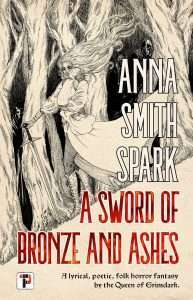 In A Sword of Bronze of Ashes Kanda’s beautiful life of loving husband, three children, lush farmland, cows who give milk that is almost all cream, is upended when a body floats down the river. Her husband and children look to her and she flees with them, a confrontation with three horrors revealing a secret she has held from them for a lifetime.
In A Sword of Bronze of Ashes Kanda’s beautiful life of loving husband, three children, lush farmland, cows who give milk that is almost all cream, is upended when a body floats down the river. Her husband and children look to her and she flees with them, a confrontation with three horrors revealing a secret she has held from them for a lifetime.
What follows is a high fantasy fever dream ride through emotional heartbreak (with the shards of your heart often then ground into the mud after), sweeping and picturesque and grotesque battles, and the breaking down and growth of Kanda as a woman and a mother.
A Sword of Bronze and Ashes is not grimdark book like we are accustomed to from the author, but Smith Spark’s first foray (that I’m aware of) into epic fantasy horror retains all the hallmarks of her beautiful storytelling ability. This book is a high fantasy that mixes Norse-style mythology storytelling when recounting stories of the Demi-god like Six in one storyline with beautiful personal action in the other as Kanda and her family flee their past and she reveals what she once was–and as a family they deal with the fallout. While I’m not much of a horror reader, A Sword of Bronze and Ashes also layers on a thick swathe of horror to make sure the darkness and fear that Smith Spark excels at delivering will keep her fans and new readers thoroughly hooked.
Smith Spark’s focus on the relationship between mother and child (mother and sons in A Woman of the Sword; and mother and daughters in A Sword of Bronze and Ashes) is really heart rending. She hits those key notes of love and rebellion and wanting impress and outdo our parents (who couldn’t possibly understand what we’re going through) so, so well. We’ve all been that child. Some of us have felt the wildly juxtaposed feelings of love and frustration as a parent, and thought some horrible thoughts about children at times. Smith Spark writes those thoughts and those feelings in a such a visceral way.
One of the things I always feel when I read a Smith Spark book is that there are so many layers of understanding and literary metaphor there for every reader. As a childless 38 year old male with relatively few struggles to face in life, I am going to take away something very different to a mother of three juggling her own person and needs with those of her children while trying to maintain her love for her husband. This is, in part the beauty of Smith Spark’s works–that you can probably revisit them over the years and have a wildly different experience.
A Sword of Bronze and Ashes by Anna Smith Spark is another gorgeous work. Peter McLean described it as “Heavy Metal Mythology” and I don’t think I could come up with a better description for where it sits within the fantasy world. I highly recommend you pick this book up.
Read A Sword of Bronze and Ashes by Anna Smith SparkThe post REVIEW: A Sword of Bronze and Ashes by Anna Smith Spark appeared first on Grimdark Magazine.
June 16, 2023
REVIEW: Battle Song by Ian Ross
England is on the brink of civil war in the 13th century as Simon de Montford and the barons of the realm challenge the power of Henry III. Caught between the battle for reform or obedience, young squire Adam de Norton longs to be a knight and win back his father’s lands. This is the first novel that I have read by author Ian Ross, but the quality and richness that he delivers in this medieval tale has ensured that it won’t be the last.
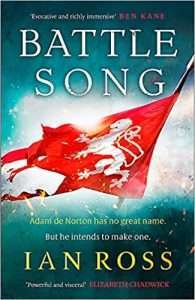 Focusing on Adam de Norton, Battle Song pairs the young squire with Sir Robert de Dunstanville, a hardened man with a fearsome reputation. Ross deftly makes the reader care about these two characters, even with Robert’s brutality shaped by a harsh world and tough decisions and this adds to the tension as the characters find themselves in life-threatening situations throughout the course of the story. Adam’s growth as a young squire looking up to a hardened veteran and trying to earn respect is well-written and reminded me of some of the best historical fiction released in recent memory by Matthew Harffy (Forest of Foes, A Time for Swords) and Bernard Cornwell (The Last Kingdom, The Empty Throne). There are even aspects that reminded me of the Alwyn Scribe from Anthony Ryan’s excellent The Pariah. Needless to say, fans of such work are in for a treat.
Focusing on Adam de Norton, Battle Song pairs the young squire with Sir Robert de Dunstanville, a hardened man with a fearsome reputation. Ross deftly makes the reader care about these two characters, even with Robert’s brutality shaped by a harsh world and tough decisions and this adds to the tension as the characters find themselves in life-threatening situations throughout the course of the story. Adam’s growth as a young squire looking up to a hardened veteran and trying to earn respect is well-written and reminded me of some of the best historical fiction released in recent memory by Matthew Harffy (Forest of Foes, A Time for Swords) and Bernard Cornwell (The Last Kingdom, The Empty Throne). There are even aspects that reminded me of the Alwyn Scribe from Anthony Ryan’s excellent The Pariah. Needless to say, fans of such work are in for a treat.
Battle Song draws you into the world of 13th century England with all the tension, fear, and excitement that you can expect from such a time. It is a well-researched novel with a land that feels real and immersive for the reader, never taking you out of the moment but instead matching excellent prose with gritty realism that can be found in the great works of historical fiction based around this period. Battles and jousting tournaments don’t feel romantic and glorious; they are brutal and bloody. There is always a sense of danger and this element allows readers to fully immerse themselves into Ross’s story and push Battle Song to greatness.
Battle Song is a must-read for fans of historical fiction. Its blend of politics, battles, tournaments, and war are mixed together with vivid characters to root for to make a story that will leave you begging for the sequel. Ian Ross has written one of the best pieces of historical fiction in years and I can’t wait to continue the journey!
The post REVIEW: Battle Song by Ian Ross appeared first on Grimdark Magazine.




